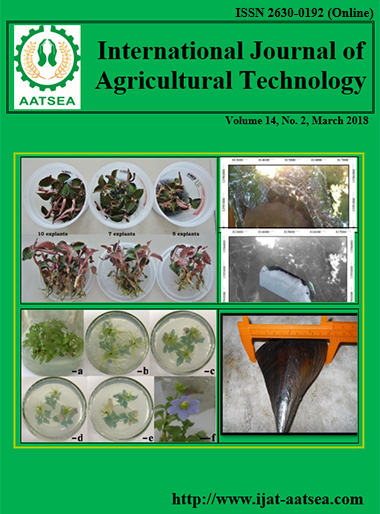Research on Efficiency of Using Cassava Chip as Based Energy and Local Legume as Protein Supplement in Concentrate for Feeding Dairy Heifer Replacement
Main Article Content
Abstract
The result revealed that initial weight of heifers were not significant but weight increase T1 was the highest weight increase among all four groups at the growth rate of 94.50 kg. or 0.45 kg./day later were T2 89.75 kg. or 0.43 kg./day T3 84.25 kg. or 0.40 kg/day and the lowest weight increase was T4 82.75 kg. or 0.40 kg./day respectively. Statically there were no significant different between T1 and T2 as same with T3 and T4 but significantly different from T1and T2 with T3 and T4 at the highly significant level of p<0.01. Total feed consumption T1 was the highest consumer at 4,116.50 kg. or 19.60 kg./day later were T2 3,981.25 kg. or 18.96 kg./day. T3 3,976.25 kg. or 18.94 kg./day and the lowest was T4 3,973.50 kg. or 18.92 kg./day. There were no significantly different among T2, T3 and T4 but significantly different with T1 at the highly significant level of p < 0.01. Total cost of feed consumption T1 was the highest cost of feed consumption at 13,065.75 Baht or 62.21 Baht./day later were T2 10,986.38 Baht or 52.32 Baht./day, T3 10,973.13 Baht or 52.26 Baht./day and the lowest was T4 10,961.00 Baht or 52.208 Baht./day. There were no significantly different among T2, T3 and T4 but highly significant different from T1 at p < 0.01. Counting the cost of feed conversion rate, it was found that T1 used the highest cost. Statically, T2,T3 and T4 were not different. The experiment revealed that local legume used as protein feed supplement significantly different to feed conversion rate and as same with the cost of feed conversion rate in feeding dairy heifer also. This result mean local legume can be used for feeding animals to replace protein food that more expensive than local legume for save the cost of feeding dairy heifer butprotein from concentrate food had more efficiency than local legume in this experiment.
Article Details

This work is licensed under a Creative Commons Attribution-NonCommercial-NoDerivatives 4.0 International License.
References
mez, A. K. and Gomez, A. A. (1984). Statistical producers for agricultural research. 2nd edition. New York: John Wiley & sons.
LDD (2009). Cassava. (Cassava chip, Cassava root). Livestock development department. Retrieved from http://www.dld.go.th/nutrition/exhibision/feed_stuff/cassava_root.html
Jamsawat, V. (2011). Research for improvment of dry roughage for feeding replacement heifer. Rajamangala University of Technology Tawan-ok Research Journal 2:75-86.
Jamsawat, V. (2013). Development of local protein feed supplement for feeding dairy Heifer. Rajamangala University of Technology Tawan-ok. Chonburi, 69 pp.
Wannapat, M. (1997). Cassava Hay: Food protein for dairy cattle. Dairy Cattle Journal 16:22-28.


